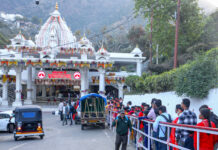 ‘One of the 10 paradises of the World’
‘One of the 10 paradises of the World’
Munnar is Kerala’s premium hill station. Surrounded by gently undulating hills swathed in the soothing green of vast tea estates makes it perfect tourist destination in south India. Situated at an altitude of 1600 m above sea level, its bracing climate with the laidback atmosphere and its delightfully refreshing colonial air makes it one of the most sought-after destinations.
Kerala itself is called God’s own country, with National Geographic Traveler selecting it as ‘One of 50 must see destinations of a lifetime’ and ‘One of the 10 paradises of the World’. And Munnar is the most popular spot in Kerala. The holiday facilities, peaceful environment and the tranquility that it provides make it the perfect serenity spot to rejuvenate and revive the most jaded of travelers.
Munnar lies in Idukki district, at the confluence of three mountain rivers. It is pronounced “Moon-aar”, meaning ‘three rivers’ in Malayalam. The rivers; Mudrapuzha, Nallathanni and Kundala meet in the center of the town. The place is encircled by wooded hills of the Annamalai Ranges, with the towering bulk of Anamudi, which is peninsular India’s highest peak, at 2695 m.
Munnar was once a sleepy little hamlet, until Scottish planters discovered it. Later the British who ruled India, developed it more into one of southern India’s most important centers for the cultivation of tea, coffee and spices. They made it their summer hideout because of the cooler climate and the mesmerizing mountain scenery. Munnar is sometimes called the ‘Switzerland of India’.
The mountain streams, valleys, tea plants and plenty to discover in the surrounding region, this hill station offers a great variety of choices. It is an excellent base for trekking through the surrounding hills, which are covered by lush green rainforests; for going picnicking beside a crystal-clear mountain stream; for wildlife watching; or for simply getting the kinks out of a tired system!
Three rivers
In both Malayalam and Tamil, the word ‘Munnar’ means three rivers, as it is merging place of three mountain streams. The Duke of Wellington was the first prominent person to visit Munnar.
Munnar was once the summer capital of the British in southern India. Some of the bungalows that were built for estate managers of British origin are still in good condition and are being used. The local people here speak Malayalam, the official language of Kerala and since there are a lot of Tamilians, the second language is Tamil.
Munnar has an ancient history and prehistoric relics that can be dated back to Stone Age civilization. The written history begins only from 10th century. In the early 19th century, the headman of the villages of Anchanad, Kannan Thevar, held lands to the north of the high ranges, which belonged to the local Rajah of Poojar.
According to record history, the first tea sapling was planted by A.H. Sharp at Parvathi, part of the present Sevenmullay estate. It consisted of 50 acres of land in the surrounding jungle.
J D Munro, a British lawyer and tea planter leased close to 600 sq. km of land around Munnar, which was then covered with thick jungle, from the Poonjar chief, a subordinate of the Maharaja of Travancore. He then cleared the jungle for tea plantations. This land was later known as Kannan Devan (Kannan Thevar) Concession Land.
Later in 1895, Messrs Finlay Muir & Company bought Munro’s land and in 1976 Tata-Finlay Ltd. purchased it. Then in 1983 James Finlay Group sold their remaining share holdings and the company became known as Tata Tea Ltd., the largest integrated tea company in the world.
Munnar is blessed with a rich variety of flora and fauna but the most well known among them is Neelakurinji
The Neelakurinji or Kurinji is a unique shrub species that blooms in Munnar and the hills across Western Ghats. Neelakurinji (Strobilanthes kunthiana) belongs to the family of Acanthaceae. The species name Kunthiana has been derived from the River Kunthi. The genus has around 300 species, of which at least 46 occur in India. Besides the Western Ghats, it can also be found in Eastern Ghats.
Neelakurinji
On the hills, the plant usually grow 30 to 60 cm in height, but under more favorable conditions they can grow well beyond 180 cms. It can be found only in high altitudes between 1,600 meters and 2,600 m and what makes it so special, apart from its beauty, is that it blooms only once in 12 years. The mass flowering and subsequent death of the Kurinji is the subject of hill folklore.
Although Neelakurinji has flowering cycles ranging from one to 16 years, it has been flowering every 12 years since 1800. What triggers the massive flowering every 12 years is not known. Plants that bloom at long intervals like this are called plietesials. But stray flowerings do occur in between. The flowering season comes between August and November and the peak in late September and October although some varieties exhibit little variation. It looks light blue in the early stage of blooming and has purplish blue color when aged.
Neela means blue in Malayalam and Kurinji is the local name of the flower. For those in Munnar, the blooming of Kurinji flower is a reminder that their lives have gone past another twelve years and for those from far off places it maybe once in a life time opportunity to witness the Kurinji flowers covering the hills of Munnar in a blanket of blue.
The Nilgiris, which means blue mountains, got its name from the blue flowers of Neelakurinji. Once they used to cover the entire Nilgiris like a carpet during their flowering season. However, now plantations and dwellings occupy much of their habitat. The departments of Tourism, Forests and Wildlife have initiated a campaign for the preservation of Neelakurinji and its natural habitat.
During the last blooming in 2006, the biggest Neelakurinji flowering was at the Eravikulam National Park in Munnar. It also bloomed gregariously at several places around Munnar and in Kodaikanal. The next mass flowering is expected to take place in 2018.
Munnar Attractions
Tea Gardens
Munnar’s top attraction is its scenic tea gardens which are a top priority on any travel itinerary in this area. There are around 30 tea estates, all privately owned (about 27 of them owned by Tata Tea Company), but most estate managers will allow visitors to wander around the estate for free. Tea factories at the estates offer a great opportunity to witness the entire process by which tea changes from being a fresh, hand picked leaf to the fragrant product that makes it to breakfast tables across the world. Some tea factories also offer tea on sale for visitors.
Mattupetty Lake and Dam
Mattupetty Lake and Dam, which lie 13 km from Munnar, en route Top Station, at an altitude of 1700 mt, are popular picnic spots. The lake and dam surrounded by wooden hills and tea plantations, makes a great view.
The Shola forests around Mattupetty are ideal for trekking and bird watching, with a variety of birds found there. Small streams and waterfalls cut through the tract here and there, which again adds more attraction to the place.
Boating is allowed on Mattupetty Lake and combined with picnic and trekking, it makes for a great outing from Munnar.
Swiss Livestock Project Farm
Also known as Mattupetti (cattle village), the Swiss Livestock Project is a highly specialized dairy farm where over a hundred breeds of high-yielding cattle are reared in eleven cattle sheds. Visitors are allowed into three of the sheds during fixed hours.
How to reach Munnar
Munnar by Air
Nearest major airport is Cochin which is about 125 km away. Taxi services are available from airport to Munnar. Cochin airport is well connected with all major cities in India and many cities abroad.
Munnar by Train
Nearest rail head is Angamaly or Alwaye, both are nearly 120 km away from Munnar. Angamaly is an important rail junction on Ernakulam-Trissur route and is well connected to all cities in India.
Munnar by Bus
Munnar is connected to other cities in Kerala and Tamil Nadu by state government public transport buses, but these are not frequent.






